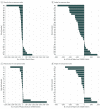Assessment of Rates of Child Maltreatment in States With Medicaid Expansion vs States Without Medicaid Expansion
- PMID: 31199444
- PMCID: PMC6575148
- DOI: 10.1001/jamanetworkopen.2019.5529
Assessment of Rates of Child Maltreatment in States With Medicaid Expansion vs States Without Medicaid Expansion
Abstract
Importance: Physical abuse and neglect affect a significant number of children in the United States. The 2014 Medicaid expansion, in which several states opted to expand their Medicaid programs, is associated with parental financial stability and access to mental health care.
Objective: To determine whether Medicaid expansion is associated with changes in physical abuse and neglect rates.
Design, setting, and participants: This ecological study used state-level National Child Abuse and Neglect Data Systems (NCANDS) data from January 1, 2010, through December 31, 2016, to compare the change in physical abuse and neglect rates in states that chose to expand Medicaid vs those that did not. All cases of physical abuse and neglect of children younger than 6 years during the study period that were referred to state-level Child Protective Services and screened in for further intervention after having met a maltreatment risk threshold were included. Cases with only documented sexual or emotional abuse were excluded. A difference-in-difference analysis was conducted from April 12, 2018, through March 26, 2019.
Exposures: State-level Medicaid expansion status.
Main outcomes and measures: Incidence rate of screened-in referrals for physical abuse or neglect per 100 000 children younger than 6 years per year by state.
Results: Data were analyzed for 31 states and the District of Columbia that expanded Medicaid and 19 states that did not during the study period, with baseline neglect counts of 646 463 and 388 265, respectively. After Medicaid expansion, 422 fewer cases of neglect per 100 000 children younger than 6 years (95% CI, -753 to -91) were reported each year after adjusting for confounders for comparison of postexpansion and preexpansion rates in states that expanded Medicaid contrasting with the change during that time in nonexpansion states. From 2013 to 2016, Medicaid coverage for adults with dependent children increased a median 1.9% (interquartile range, 0.4% to 4.3%) in the states that did not expand Medicaid and 4.2% (interquartile range, 0.9% to 6.0%) in the states that did. No associations were found between Medicaid coverage or Medicaid eligibility criteria and physical abuse or neglect rates.
Conclusions and relevance: Medicaid expansion was associated with a reduction in the reported child neglect rate, but not the physical abuse rate. These findings suggest that expanding Medicaid may help prevent child neglect.
Conflict of interest statement
Figures


Comment in
-
Prevention of Child Maltreatment as an Unexpected Benefit of Social Policies.JAMA Netw Open. 2019 Jun 5;2(6):e195521. doi: 10.1001/jamanetworkopen.2019.5521. JAMA Netw Open. 2019. PMID: 31199440 No abstract available.
References
-
- National Council of Juvenile and Family Court Judges Adverse Childhood Experience (ACE) questionnaire. http://www.ncjfcj.org/sites/default/files/Finding%20Your%20ACE%20Score.pdf. Published October 24, 2006. Accessed December 5, 2016.
-
- US Department of Health and Human Services Child abuse and neglect cost the United States $124 billion. http://www.cdc.gov/media/releases/2012/p0201_child_abuse.html. Published February 1, 2012. Accessed December 5, 2016.
Publication types
MeSH terms
LinkOut - more resources
Full Text Sources
Medical
Miscellaneous

